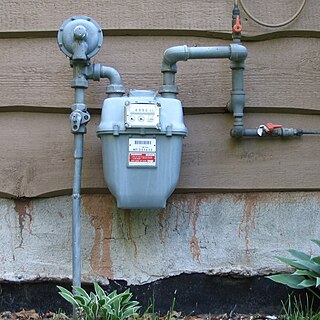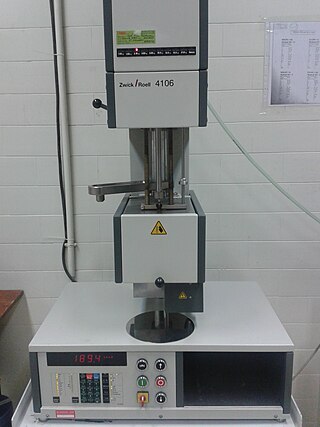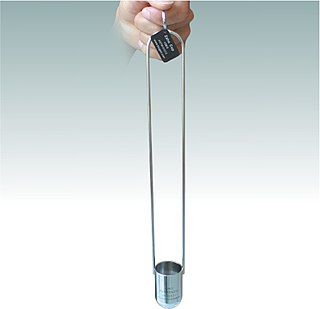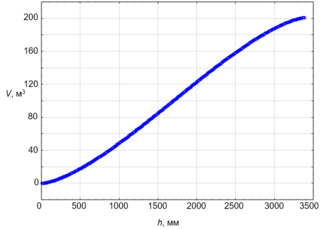Related Research Articles

Horsepower (hp) is a unit of measurement of power, or the rate at which work is done, usually in reference to the output of engines or motors. There are many different standards and types of horsepower. Two common definitions used today are the imperial horsepower, which is about 745.7 watts, and the metric horsepower, which is approximately 735.5 watts.
A viscometer is an instrument used to measure the viscosity of a fluid. For liquids with viscosities which vary with flow conditions, an instrument called a rheometer is used. Thus, a rheometer can be considered as a special type of viscometer. Viscometers can measure only constant viscosity, that is, viscosity that does not change with flow conditions.
Flow measurement is the quantification of bulk fluid movement. Flow can be measured using devices called flowmeters in various ways. The common types of flowmeters with industrial applications are listed below:

A blower door is a machine used to perform a building air leakage test. It can also be used to measure airflow between building zones, to test ductwork airtightness and to help physically locate air leakage sites in the building envelope.

A rotameter is a device that measures the volumetric flow rate of fluid in a closed tube.

A gas meter is a specialized flow meter, used to measure the volume of fuel gases such as natural gas and liquefied petroleum gas. Gas meters are used at residential, commercial, and industrial buildings that consume fuel gas supplied by a gas utility. Gases are more difficult to measure than liquids, because measured volumes are highly affected by temperature and pressure. Gas meters measure a defined volume, regardless of the pressurized quantity or quality of the gas flowing through the meter. Temperature, pressure, and heating value compensation must be made to measure actual amount and value of gas moving through a meter.
An orifice plate is a device used for measuring flow rate, for reducing pressure or for restricting flow.

A rheometer is a laboratory device used to measure the way in which a viscous fluid flows in response to applied forces. It is used for those fluids which cannot be defined by a single value of viscosity and therefore require more parameters to be set and measured than is the case for a viscometer. It measures the rheology of the fluid.

The Melt Flow Index (MFI) is a measure of the ease of flow of the melt of a thermoplastic polymer. It is defined as the mass of polymer, in grams, flowing in ten minutes through a capillary of a specific diameter and length by a pressure applied via prescribed alternative gravimetric weights for alternative prescribed temperatures. Polymer processors usually correlate the value of MFI with the polymer grade that they have to choose for different processes, and most often this value is not accompanied by the units, because it is taken for granted to be g/10min. Similarly, the test conditions of MFI measurement are normally expressed in kilograms rather than any other units. The method is described in the similar standards ASTM D1238 and ISO 1133.

A Zahn cup is a viscosity measurement device used in the paint industry. It is commonly a stainless steel cup with a tiny hole drilled in the centre of the bottom of the cup. There is also a long handle attached to the sides. There are five cup specifications, labelled Zahn cup #x, where x is the number from one through five. Large number cup sizes are used when viscosity is high, while low number cup sizes are used when viscosity is low. They are manufactured in accordance to ASTM D 4212, ASTM D1084 and ASTM D816

The Marsh funnel is a simple device for measuring viscosity by observing the time it takes a known volume of liquid to flow from a cone through a short tube. It is standardized for use by mud engineers to check the quality of drilling mud. Other cones with different geometries and orifice arrangements are called flow cones, but have the same operating principle.

A flow computer is an electronic computer which implements algorithms using the analog and digital signals received from flow meters, temperature, pressure and density transmitters to which it is connected into volumes at base conditions. They are used for custody or fiscal transfer.

A positive displacement meter is a type of flow meter that requires fluid to mechanically displace components in the meter in order for flow measurement. Positive displacement (PD) flow meters measure the volumetric flow rate of a moving fluid or gas by dividing the media into fixed, metered volumes. A basic analogy would be holding a bucket below a tap, filling it to a set level, then quickly replacing it with another bucket and timing the rate at which the buckets are filled. With appropriate pressure and temperature compensation, the mass flow rate can be accurately determined.

Custody Transfer in the oil and gas industry refers to the transactions involving transporting physical substance from one operator to another. This includes the transferring of raw and refined petroleum between tanks and railway tank cars; onto ships, and other transactions. Custody transfer in fluid measurement is defined as a metering point (location) where the fluid is being measured for sale from one party to another. During custody transfer, accuracy is of great importance to both the company delivering the material and the eventual recipient, when transferring a material.

The oscillating U-tube is a technique to determine the density of liquids and gases based on an electronic measurement of the frequency of oscillation, from which the density value is calculated. This measuring principle is based on the Mass-Spring Model.

The Ford viscosity cup is a simple gravity device that permits the timed flow of a known volume of liquid passing through an orifice located at the bottom. Under ideal conditions, this rate of flow would be proportional to the kinematic viscosity that is dependent upon the specific gravity of the draining liquid. However, the conditions in a simple flow cup are seldom ideal for making true measurements of viscosity. It is important when using a Ford Cup and when retesting liquids that the temperature of the cup and the liquid is maintained, as ambient temperature makes a significant difference to viscosity and thus flow rate.

The viscosity of a fluid is a measure of its resistance to deformation at a given rate. For liquids, it corresponds to the informal concept of "thickness": for example, syrup has a higher viscosity than water. Viscosity is defined scientifically as a force multiplied by a time divided by an area. Thus its SI units are newton-seconds per square meter, or pascal-seconds.
Flow conditioning ensures that the "real world" environment closely resembles the "laboratory" environment for proper performance of inferential flowmeters like orifice, turbine, coriolis, ultrasonic etc.

A spray is a dynamic collection of drops dispersed in a gas. The process of forming a spray is known as atomization. A spray nozzle is the device used to generate a spray. The two main uses of sprays are to distribute material over a cross-section and to generate liquid surface area. There are thousands of applications in which sprays allow material to be used most efficiently. The spray characteristics required must be understood in order to select the most appropriate technology, optimal device and size.
Dimensionless numbers have an important role in analyzing the behavior of fluids and their flow as well as in other transport phenomena. They include the Reynolds and the Mach numbers, which describe as ratios the relative magnitude of fluid and physical system characteristics, such as density, viscosity, speed of sound, and flow speed. To compare a real situation with a small-scale model it is necessary to keep the important characteristic numbers the same. Names and formulation of these numbers were standardized in ISO 31-12 and in ISO 80000-11.
References
- ↑ "Definition of VISCOSITY".
- ↑ Viscosity Archived 2013-05-12 at the Wayback Machine . BYK-Gardner GmbH
- ↑ "ASTM D1200 - 10(2018) Standard Test Method for Viscosity by Ford Viscosity Cup".
- ↑ ISO 2431:2011